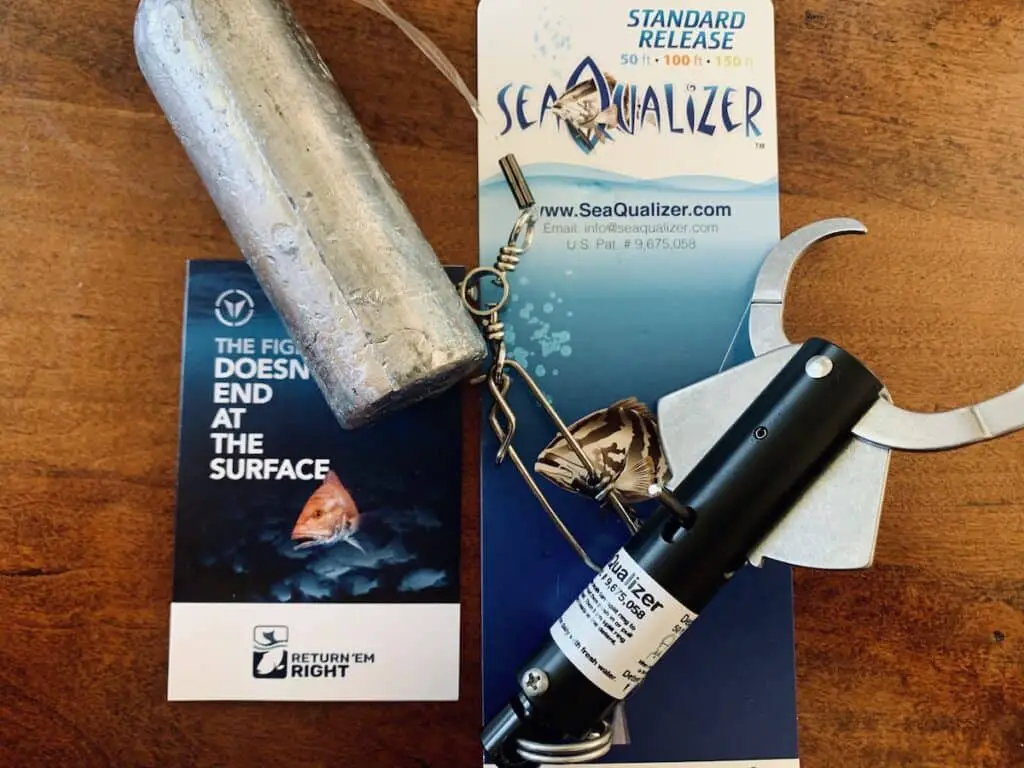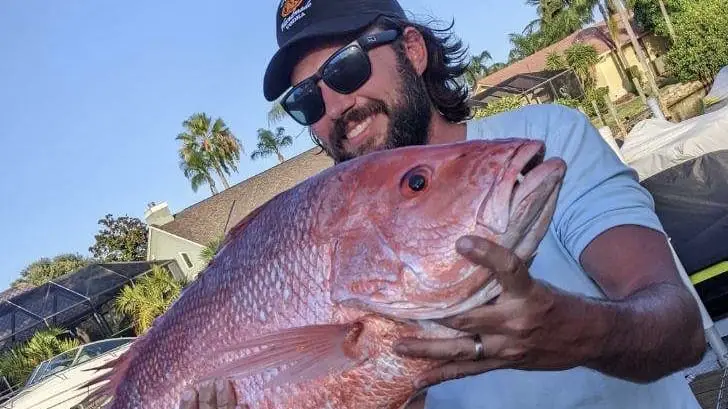What fish do you catch for bottom fishing?
Whenever fishermen are positioned around offshore reef or structure, they will typically employ a variety of techniques to target fish throughout the water column. Trolling is usually done to target pelagic and surface feeding species. At times when bottom dwelling fish are targeted, bottom fishing is the best technique.
Bottom dwelling fish caught with bottom fishing techniques include grouper, snapper, tilefish, hogfish, and flounder. These fish are frequently found near reefs or wrecks with plentiful baitfish. Some bottom fish, like tilefish, are found in soft mud.
In this article, I’ll share information about different bottom fish and how to target them. Read below to learn more before you’re next outing.
How to Target Grouper
When you find grouper, you’ll generally see several of them, even though they’re not considered schooling fish. You’ll find them around reefs, wrecks, rocky ledges, and any other structure that provides shelter from predators. Grouper prefer water depths of at least 50 feet. They are very fast and will quickly dart back into the reef or wreck once they take your bait. Grouper feed on small crabs, crustaceans, squid, and small baitfish.
To target grouper, you’ll want to keep your bait right on the bottom. I recommend using a knocker rig with cut bait and a high drag setting. These fish will pull away quickly, which means your reel will need to have drag that engages quickly. To learn more about how to set up a knocker rig, read my article Bottom Fishing Rigs.
Your leader line likely needs to be 60-80 lb in strength to withstand the fish attempting to break off the line on the reef or wreck. It will be an awful feeling if you catch a big one and lose it right after the strike!
How to Target Snapper
Snapper can be identified using sonar as the boat is traveling near an oil rig or reef or wreck. They travel in schools which makes it easier to identify them on sonar. The coveted red snapper is usually found in water depths between 80 and 400 feet, although they have been found a bit shallower too.
Snapper are frequently targeted because they make great tablefare and are also fun to target. Similar to grouper, snapper will jerk your bait right back into the reef after a strike, so you’ll need to rapidly retrieve the line once you feel a strike.
As far as rigging for snapper goes, I like to use a hi/low rig, also called a chicken rig, with live bait because I usually will catch snapper slightly above bottom. For some reason, they tend to strike a little higher than grouper. The hi/low rig keeps one bait on bottom and another slightly higher in the water column.
You’ll also need to remain aware of any regulations in your area regarding snapper. I’m on the Atlantic coast of Florida, so my snapper season is only a couple days a year in the summer. I also am required to use non-stainless steel circle hooks when targeting any reef species. Read more about hook regulations in my article Bottom Fishing Hooks.
How to Target Hogfish
If you’re fishing in the Gulf of Mexico near wintertime, hogfish are a great fish to target. When on the Atlantic side of Florida, the hogfish open season ends October 31, so you’ll need to get out there in fall instead.
Keeper hogfish are pretty large. On the Gulf side, they’re 14 inches to the fork and on the Atlantic side, you can keep them if they’re 16 inches to the fork. These fish are strong once they’re hooked and you’ll need heavy tackle for them.
Hogfish are great to eat. I actually saw whole hogfish at the seafood counter in my local Publix last weekend. I usually find hogfish near ledges or rocky bottoms. Target them with hook and line with shrimp as bait or a common way to catch them is actually spearfishing.
How to Target Flounder
Flounder has a short closed season in Florida. October 15-November 30 you cannot legally target and keep flounder. Flounder must be at least 14 inches in length.
Most often, I’ll find flounder in sandy, muddy areas. Flounder are flat fish that like to burrow into the sand to escape predators. I’ve noticed that I catch the most with live bait, as long as I have it rigged with a sinker and a bead for extra commotion.
How to Target Tilefish
Blueline and golden tilefish are frequently targeted by anglers. They can be fun to target because of the different methods used to catch them. You’ll need to find almost the smoothest bottom you can in deep waters, and they’re likely burrowed in the sand at the bottom.
Shrimp and other crustaceans make great bait for tilefish. Rig them with an egg sinker and a noisy bead, similar to how you might rig for flounder, and drag the bait along the said while the boat drifts. The disruption in the sand will catch their attention and you’ll get lots of strikes once you find them.
Because of the depth of water tilefish are usually found in, some anglers will use a deep drop setup to catch them. You can catch them in waters 250 feet deep, which wouldn't be so bad with a manual retrieve, but closer to 900+ feet and you’ll be cranking for a while to pull one in the boat.
Although they’re usually found on sandy bottom, tilefish are considered reef fish and are subject to the reef fish gear rules, meaning you’ll need to use non-stainless steel and potentially non-offset circle hooks with your shrimp bait.
Grouper, snapper, flounder, hogfish, and tilefish are some of the most commonly targeted bottom fish. However, you will likely find that you also catch bait fish such as grunts when bottom fishing. It can actually be a blessing in disguise because the baitfish bycatch can set you up nicely for your next drop to snapper.
Releasing Bottom Fish Properly
Sometimes fish will need to be released if you catch a species that doesn't meet minimum slot size requirements, or if you catch a species during it's closed season. Bottom fish have a swim bladder which they inflate and deflate to maintain pressure equilibrium at various depths. When bottom fish experience barotrauma from coming to the surface too quickly, the swim bladder can bulge out of the mouth of the fish.
When a bottom fish is released right at the surface, it can struggle to get to the proper depth because it's internal pressure is out of balance with the surface pressure. Bringing the fish down to depth before releasing it has shown a dramatic improvement in the mortality rate of released bottom fish.
The Federal DESCEND act requires the use of a descending device or venting tool when releasing bottom fish. A venting tool is a hollow needle that's used to puncture a hole in the swim bladder and allow the release of gas. Once the gas vents out, the fish is released at the surface. The fish is then able to descend and control it's swim bladder appropriately.
The issue with a venting tool is that its very easy to puncture a hole in the wrong part of the fish. A misplaced needle can put a dangerous hole in the fish's stomach and cause more harm than good. For this reason, most anglers will opt for a descending device instead.
A descending device is a tool that clips or hooks on to the fish's lip and brings it down to a certain depth, ideally half the depth it was caught in. The descending device is designed to release the fish once it reaches the desired depth.
The Seaqualizer is a unique descending device. It is equipped with a pressure sensor that you set prior to release. You'll need to rig the Seaqualizer with a sinker to help the fish descend, then clip the fish's lip with the Seaqualizer, set the depth to half the water depth, and drop the fish in the water. This tool helps release the fish quickly to improve it's survival.

I qualified for a free Seaqualizer from the Return ‘Em Right program and recently received mine in the mail. I took a short, free course on how to use the Seaqualizer and the importance of decreasing the mortality rate of catch and release bottom fish. If you'd like to see if you qualify for free gear, visit the Return ‘Em Right website, here.
I hope this article helped you learn about some common bottom fish. To learn about more aspects of bottom fishing, check out my comprehensive guide here. Tight lines, y’all!
Recent Posts
Fat Cow Jig Strips: The Ultimate Bucktail Jig Upgrade for Surf Fishing
As discussed in my previous article, "Surf Fishing with Bucktail Jigs: Ultimate Guide for Beach Anglers," bucktail jigs are a staple in any surf angler's tackle box, offering a versatile way to catch...
In my previous article, "Surf Fishing with Bucktail Jigs: Ultimate Guide for Beach Anglers," I introduced you to the bucktail jig and discussed how versatile of a lure it is for catching a wide range...

